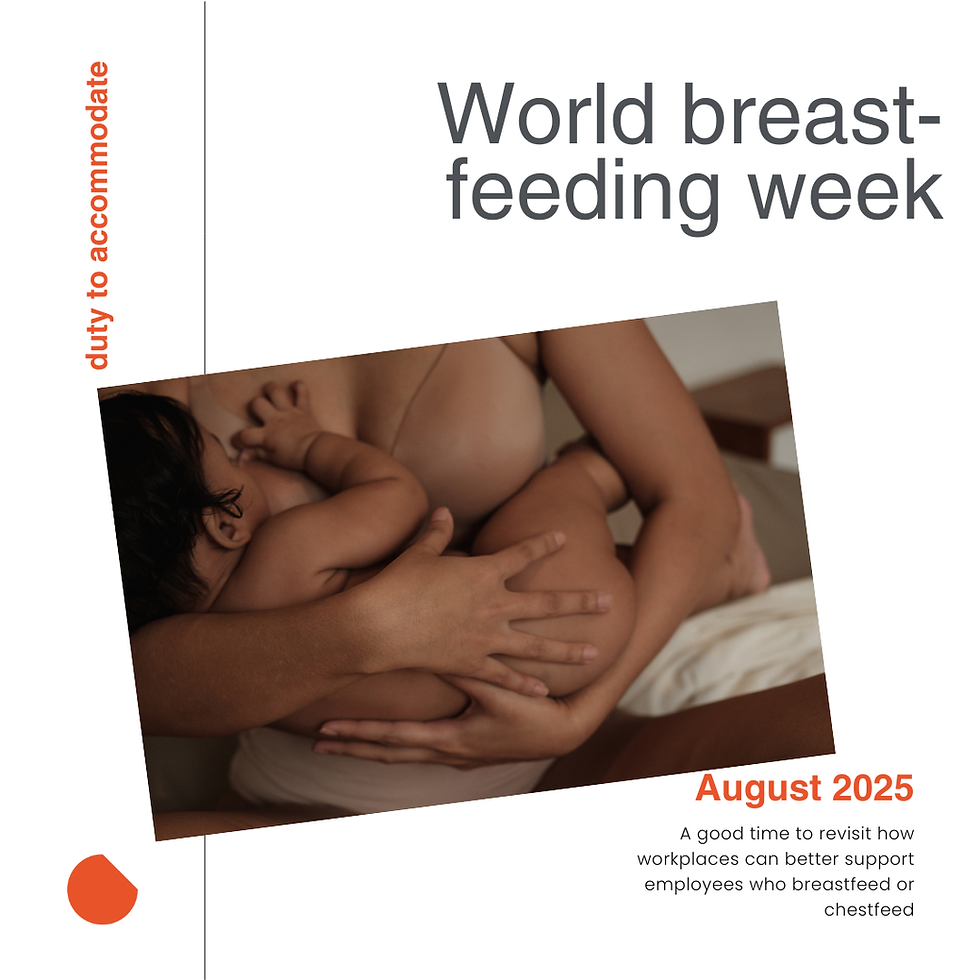Breast/Chestfeeding at Work: What Employers and HR Need to Know
- Rika Sawatsky

- Aug 6
- 3 min read
Updated: Aug 21

In honour of World Breastfeeding Week 2025, it’s a good time to revisit how workplaces can better support employees who breastfeed or chestfeed. While the law provides certain protections, many employers miss opportunities to go beyond compliance and create truly inclusive, supportive environments.
Below is a quick overview of the legal framework, best practices, and resources for employers.
The Law: A Very Quick Primer
Legal protections for breast/chestfeeding vary across Canada. Here are a few key points:
Federal level: Breast/chestfeeding discrimination is treated as a matter of family status. Problematic in my view, the federal framework allows employers to require proof that the employee has a legal obligation to continue breast/chestfeeding—meaning that choosing to breast/chestfeed isn’t enough.
Most provinces: Treat breast/chestfeeding discrimination as related to sex and/or family status.
Family status tests differ by jurisdiction: Employers should consult counsel before making accommodation decisions.
Ontario: No requirement to prove a legal obligation. The Ontario Human Rights Commission (OHRC) encourages accommodating employee choice to the point of undue hardship, without requiring medical proof.
Best Practices for Employers on Breast/Chestfeeding
1. Policy Integration
Include a breast/chestfeeding accommodation policy in pregnancy, parental leave, and return-to-work materials. Clear, written guidance helps normalize accommodations and set expectations for both managers and employees.
2. Training Managers
Equip managers to respond to requests with sensitivity, consistency, and confidentiality. An untrained or dismissive response can turn a simple accommodation request into a legal or cultural problem.
3. Inclusive Language
Learn and use inclusive terms like chestfeeding and recognize that non-binary people, trans men, and other gender diverse folks may choose to nurse their kids. You may not always get it right—but a willingness to learn and accept feedback goes a long way.
🔗 Resources:
4. Respect Diverse Realities
Not all parents who have the physiological ability to breast/chestfeed choose to do so. Among those who do, there are many experiences to anticipate and respect:
Some express milk rather than nurse directly.
Some pump and discard or donate milk (e.g. following miscarriage, stillbirth, or surrogacy).
Children older than infants may still nurse.
These nuances can affect whether a request falls under sex or family status grounds, and they highlight the need for individualized approaches.
5. Individualized Accommodation
Accommodation requests may include:
Extra breaks for nursing or pumping (note: this is not “time off”).
On-site expressing or nursing spaces.
Flexible scheduling or remote work options.
Employers should prepare for flexibility and consider bona fide occupational requirements in advance to avoid delays in the accommodation process.
6. Pumping/Nursing Spaces
Provide spaces that are:
Quiet, clean, and private.
Equipped with washing/sterilizing facilities and storage for equipment.
Stocked with a fridge for safe milk storage (as per public health guidelines).
Managed with a scheduling system, if multiple employees need access.
🔗 Resources:
(Note: These toolkits contain excellent recommendations but often use non-inclusive language and imagery. Employers should adapt them to reflect inclusive practices.)
Moving Beyond Compliance
Creating a breast/chestfeeding-friendly workplace is not just about meeting minimum legal obligations. It’s about fostering a culture of respect, inclusion, and gender equity. Employers who get this right improve retention, employee well-being, and organizational reputation.
As part of my work with employers, I help design policies and training that are both legally compliant and equity-driven. If your organization is reviewing parental leave or return-to-work policies, this is the perfect moment to include breast/chestfeeding accommodations in that review.
👉 Contact me to learn more about how I can support your workplace.

